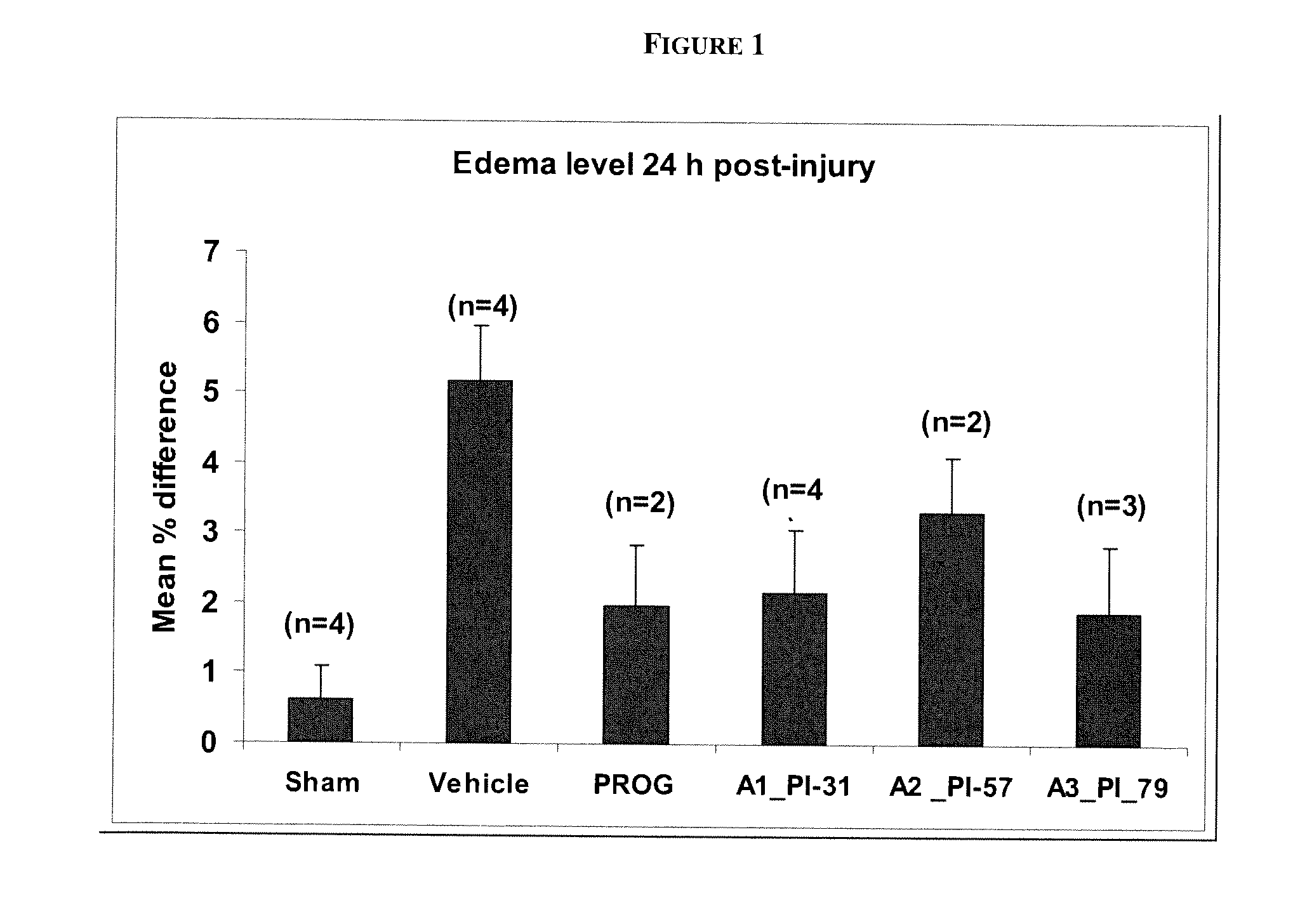Methods of neuroprotection using neuroprotective steroids and a vitamin d
a neuroprotective steroid and vitamin d technology, applied in the field of pharmaceutical chemistry, can solve the problems that patients are also at risk of suffering from vitamin d deficiency, and achieve the effects of enhancing physical recovery, preventing neurodegeneration, and avoiding or reducing neurodegeneration due to apoptosis
- Summary
- Abstract
- Description
- Claims
- Application Information
AI Technical Summary
Benefits of technology
Problems solved by technology
Method used
Image
Examples
example 1
Preparation of Steroid Analogs
[0563]All reagents were obtained from Aldrich. Reactions requiring anhydrous conditions were performed in oven-dried glassware under dry argon. All solvents used were anhydrous or kept dry over activated 4 Å molecular sieves. Convection was achieved by use of a magnetic stirring bar unless otherwise noted. The following abbreviations may be used: dichloromethane (DCM), diethyl ether (ether), water (DI), hexane (hex), ethyl acetate (ea), dimethylformamide (DMF), acctonitrile (ACN), tetrahydrofuran (THF), round bottomed flask (RBF), hours (h), minutes (min), millimole (mmol), equivalents (eq). Reaction progxess was monitored via thin-layer chromatography (TLC) on pre-coated glass-backed plates (silica gel 60 Å F254, 0.25 mm thickness) purchased from EM Science. Flash chromatography was carried out with silica gel 60 Å (230-400 mesh) from Sorbent Technologies. Automated chromatography was performed on an Isco Combiflash Companion. Unless otherwise stated, ...
example 1a
C-3 Progesterone Derivatives
[0564]
[0565]3-β-Hydroxy-progesterone (2). Progesterone (3.14 g, 10.0 mmol) was added with cerium chloride heptahydrate (3.73 g, 10.0 mmol, 1.00 eq) to an oven dried three necked 250 mL RBF with thermometer. Methanol (100 mL) was added under argon and the solution was chilled to −20° C. Sodium borohydride (0.189 g, 5.00 mmol, 0.500 eq) was then added in bulk. Solution temperature raised briefly up to −16° C. After 15 minutes, 37 mL acetone was added and the solution was warmed to ambient temperature. Water (25 mL) was added and the solvent volume was reduced by approximately 100 mL. Ether was added, along with more water, which caused the solution to become clear and colorless. The aqueous layer was extracted with ether. The organic layers were combined, washed with brine, dried, filtered, and concentrated to give 3.14 g white solid. The solid was prepared as a silica cake, loaded onto a 500 mL silica column, and eluted with 3 L 20% ethyl acetate in hexane...
example 1b
C-20 Progesterone Derivatives
[0569]
[0570]3,20-Hydroxy-progesterone (4a). An oven dried RBF was charged with 25 mL anhydrous THF and chilled in an ice bath. A 4.50 mL volume (9.00 mmol, 2.25 eq) of 2.0 M lithium aluminum hydride in THF was added. A separate ˜10 mL solution of progesterone (1.26 g, 4.00 mmol) in anhydrous THF was prepared in a dry flask. The solution was transferred to the reaction flask dropwise over 30 minutes. The mixture was heated under reflux for 1 h, cooled to room temperature, and quenched by the addition of ethyl acetate, followed by aqueous sodium sulfate. Solid sodium sulfate was added to remove excess water. The remaining salts were filtered and washed with THF. The organic filtrates were combined and concentrated to give 1.24 g (97%, recovered with 8% progesterone) white crystalline solid.
[0571]20-S-Hydroxy-progesterone (4). A 100 mL RBF was charged with 1.00 g crude compound 5 and 5.00 g manganese dioxide (activated by heating in oven for 2 days then coo...
PUM
 Login to View More
Login to View More Abstract
Description
Claims
Application Information
 Login to View More
Login to View More - R&D
- Intellectual Property
- Life Sciences
- Materials
- Tech Scout
- Unparalleled Data Quality
- Higher Quality Content
- 60% Fewer Hallucinations
Browse by: Latest US Patents, China's latest patents, Technical Efficacy Thesaurus, Application Domain, Technology Topic, Popular Technical Reports.
© 2025 PatSnap. All rights reserved.Legal|Privacy policy|Modern Slavery Act Transparency Statement|Sitemap|About US| Contact US: help@patsnap.com



